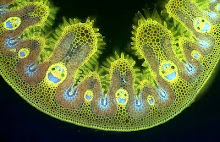Henbane Hyoscyamus niger is a poisonous member of the potato family and has a long history of use by murderers. Its gruesome history, sombre colours and veined petals give it an aura of menace. It's reputed (controversially) to be the poison used by Hamlet's uncle to poison the prince's father, by pouring it in his ear, in Shakespeare's tragedy Hamlet.
Sleeping within mine orchard,
My custom always in the afternoon,
Upon my secure hour thy uncle stole,With juice of cursed hebona [henbane] in a vial,
And in the porches of mine ears did pour
The leperous distilment; whose effect
Holds such as enmity with blood of man
That swift as quicksilver it courses through
The natural gates and alleys of the body,
And with a sudden vigour it doth posset
And curd, like eager droppings into milk,
The thin and wholesome blood: so dit it mine:
And a most instant tetter bark’d about,
Most lazar-like, with vile and loathsome crust,
All my smooth body.
More recently Hawley Harvey Crippen is reputed to have used it to kill his wife Cora in a notorious case in 1910, when the new-fangled wireless telegraph was used to aid the interception of the fugitive as he fled to Canada.
Like so many plant poisons, the toxic alkaloids found in henbane have medicinal applications and were once used as a hazardous anaesthetic by dentists. The herbalist John Gerard left a graphic account of their use in his herbal of 1597.
“Henbane", he wrote, " causeth drowsinesse, and mitigateth all kinde of paine… ………the leaves, seed, and juice taken inwardly cause an unquiet sleep like unto the sleep of drunkennesse, which continueth long, and is deadly to the party.
The seed is used by Mountibank tooth-drawers which run about the country, to cause worms to come forth of the teeth, by burning it in a chafing dish of coles, the party holding his mouth over the fume thereof: but some crafty companions to gain money convey small lute-strings into the water, persuading the patient, that those small creepers came out of his mouth or other parts which he intended to ease.”
In 2008 celebrity chef Anthony Worrall Thompson confused the poisonous henbane for the edible weed fat hen and published a recipe for its use in salads – a lurid example of the dangers of only knowing common colloquial names for plants rather than identifying them by their scientific names. No one is known to have suffered illness from the chef’s error, perhaps because henbane is not a common wild plant, and the chef didn’t seem to be too perturbed by his mistake. "I was thinking of a wild plant with a similar name, not this herb. It's a bit embarrassing, but there have been no reports of any casualties. Please do pass on my apologies", was his comment.
Franz Eugen Köhler, Köhler's Medizinal-Pflanzen 1897
Image Source: http://upload.wikimedia.org/wikipedia/commons/6/66/Koeh-073.jpg















